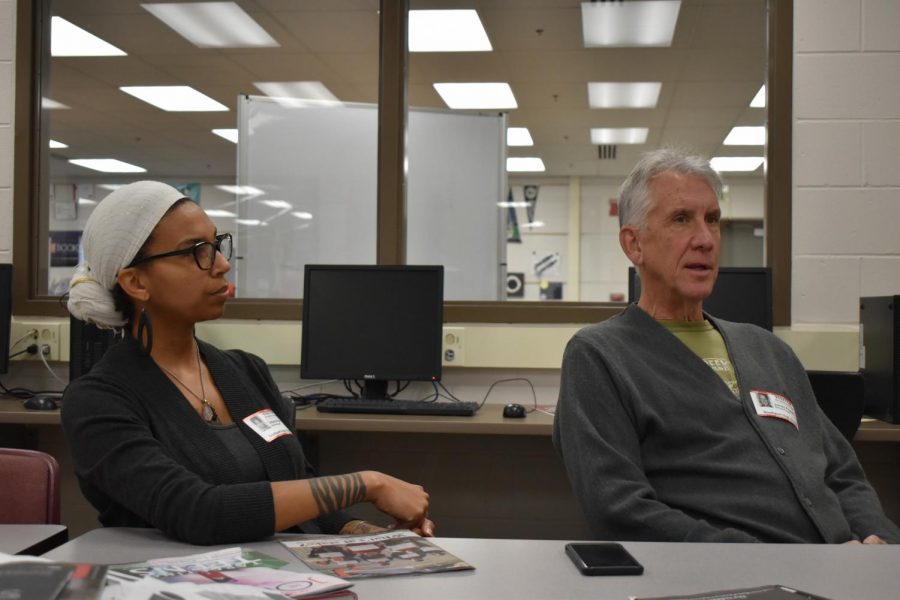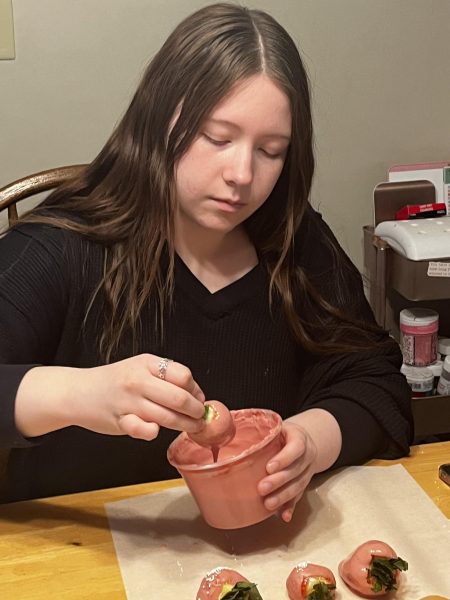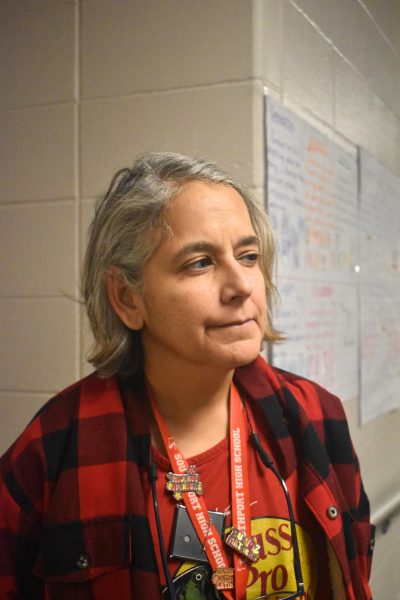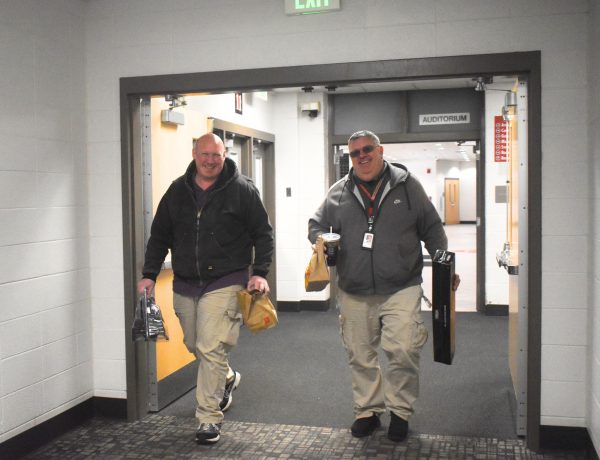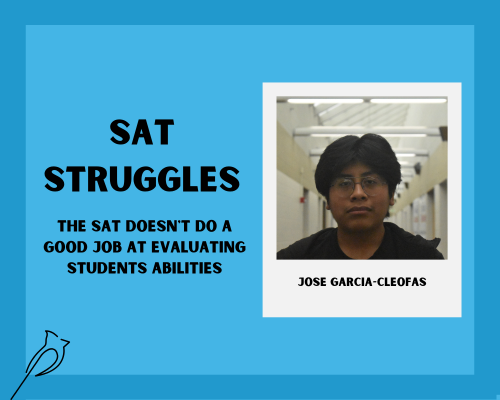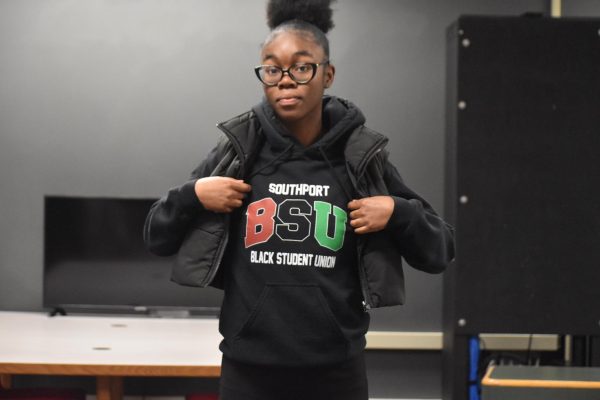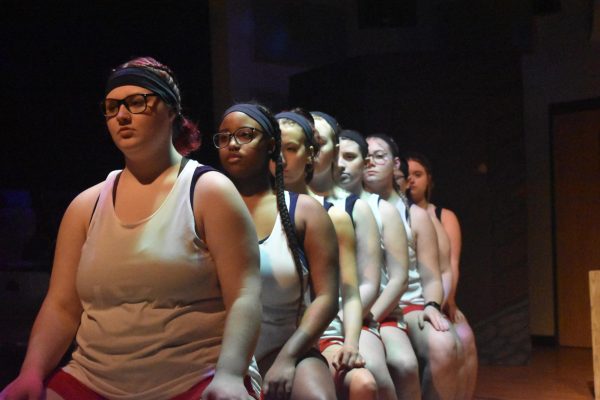To the test
The Journal investigates environmental sustainability at SHS
Executive Director Jim Poyser and Resilient Schools Coordinator Tatjana Rebelle from Earth Charter Indiana talk with The Journal during iPass on Jan. 16. This interview followed a walkthrough of SHS to see how sustainable the school is.
Drinking from plastic straws, driving a car, throwing away plastic water bottles, using plastic bags at the grocery store and charging electronic devices overnight are all things that humans do that harm the environment. According to Carbon Brief, a U.K.- based website specializing in promoting the understanding of climate change, human emissions and activities are responsible for nearly 100% of global warming since 1950.
Aware of the impact humans have on the environment, The Journal wanted to put SHS up to the test over its sustainability. According to science teacher Rachel Brunsell, sustainability is living in a way that there are enough resources for the present, but also for the future. She views it not just as a practice, but as a way of life. Because human activity is largely responsible for climate change, we, The Journal, wanted to see how a building where more than 2,000 students and hundreds of teachers attend daily was impacting the environment and its future.
“As a school, we know how impactful schools can be on the environment,” Haley Miller, Editor In Chief of The Journal, said. “The Journal decided to investigate this, in terms of Southport, so that we could let our students know exactly how much their school was contributing to a carbon footprint and what their school could be doing.”
In order to test SHS’s sustainability, we turned to Jim Poyser and Tatjana Rebelle, the Executive Director and Resilient Schools Coordinator respectively at Earth Charter Indiana, a nonprofit organization that focuses on building principles for a sustainable environment.
To prepare to test the school’s sustainability, The Journal received permission from the school’s administrators for Poyser and Rebelle to perform a walkthrough. They visited the school during iPass on Jan. 16 and talked us through everything that they observed in order to tell us if SHS is going down the right environmental path.
The positives
A sustainable switch that Perry Township made recently was installing LED lights in each building in the district. This change is complete at SHS, and the LEDs have been installed in the hallways, classrooms and parking lots.
“The LED lights take far less energy than the traditional lighting options, so that utilizes less energy and is a plus to the electricity bill,” Poyser said.
Though aware that on the day of the walkthrough many lights weren’t being used because of presentations during iPass, Poyser still pointed out that the lack of light impressed him. He says classrooms with the lights off at any time of the day deserve a “grade A” because of the energy they are preserving.
Poyser also noted that the amount of light being let into the main hallway, the fishbowl, results in less energy use. The use of light sensors in the labs, bathrooms and offices throughout the school also helps to prevent wasting energy by leaving lights on.
In addition to SHS’s energy-friendly approach to lighting, Poyser was impressed by the food bins in the cafeteria for students to place uneaten items in. The items put in these bins are saved for the after-school lunches that the cafeteria offers or are donated to different food banks. Poyser and Rebelle say that the Elkay water fountains, water fountains with water bottle filling stations, are also a great way to move toward sustainability because they have accounted for 466,986 of refills, allowing for less plastic waste.
Overall, Poyser and Rebelle pointed out many things that the school is doing well.
“I was extremely impressed,” Rebelle said. “You guys seem, comparatively to a lot of the other schools I’ve gone into, already ahead of the game with a lot of things.”
Areas for improvement
Poyser offered The Journal some suggestions about ways to increase the sustainability of SHS. One suggestion that Poyser gave was the idea of straying away from styrofoam lunch trays completely and replacing the plastic silverware with metal silverware. According to Children’s Environmental Health Network, the production of styrofoam releases over 50 chemical byproducts that then contaminate the air and overall community.
SHS has slowly made an effort to switch from almost all styrofoam lunch trays to plastic reusable trays in the lunch lines. According to Knight, plastic hasn’t completely replaced styrofoam because the cafeteria staff would have to wash plastic lunch trays in between the three lunch periods. Knight, though, says he still feels like the change has reduced the amount of overall waste.
“The amount of trash we were throwing away plus the amount of styrofoam we were throwing away was very substantial,” Principal Brian Knight said.
Both Poyser and Knight acknowledge the fact that switching over to metal silverware could be challenging. The entire cafeteria staff would have to get on board and be willing to possibly work longer or change their shift schedules to wash more dishes.
Another suggestion Poyser made was to implement a food waste program. Although there are food bins for uneaten items in the cafeteria, he says that the leftover waste from the school still sits in landfills and creates methane gas. He suggests bringing in a professional composter to the school to minimize this effect.
Poyser says the walkthrough was not meant to harshly judge what SHS is doing but to simply encourage the school to continue taking sustainable measures and improving in other areas where they were lacking. The negative impact a school can have on the environment adds up over time. Rebelle says that if schools start changing their ways, it will spark change in their community, too.
“This is a school, and the theory of school is education,” Rebelle said. “And if you can get to have climate change and environmental justice and that kind of thing talked about in schools, that will bleed into the neighborhood and into the community.”
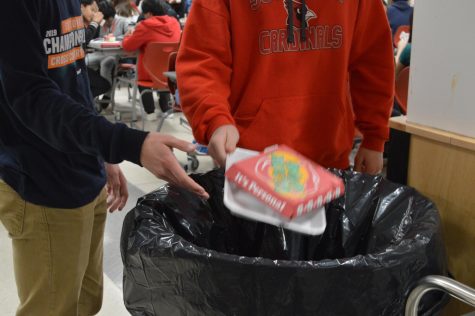
Students throw away their trash on Jan. 23. Jim Poyser suggests SHS should stray away from styrofoam lunch trays because of their negative impact on the environment.
What the district is doing
According to Perry Township’s Director of Facilities, Kirby Schott, the district is wrapping up the LED conversion. Over 30,000 light fixtures have been completely swapped or retrofitted in the district. Due to the high cost of replacing the lights in those areas, this statistic excludes the facilities for football, soccer, softball and baseball. Schott wrote the saving benefits of switching the lights in the hallways, classrooms and parking lots will come much quicker than possible benefits of placing LED lights in the sports areas.
Solar panels, like LED lights, were a topic of school board conversation. When it comes to solar panels for Perry Township, Schott wrote that it is a matter of where to put them and how to plan for its initial financial impact.
“We have explored solar some,” Schott wrote in an email interview with The Journal. “Here in Indiana, the incentives offered to both consumers and energy providers from the state aren’t great, so the initial costs are still pretty significant.”
Schott wrote that in 2019, IPL chose Perry Township to be a part of a program called CLEAResult, which coincided with the LED lights project. They did a monthly analysis of opportunities for the district to be more energy efficient. The program was offered to the township at no cost and offered some financial incentives based on the township’s energy usage. According to Schott, the more energy the district saves, the more money they get back. However, Schott hasn’t received exact data on this project just yet.
“While we don’t have perfect data yet, I can tell you we are headed in the right direction,” Schott wrote.
What other schools are doing
Just as SHS and Perry Township have made several changes to be more sustainable for the Earth, other schools have been making efforts to reduce their carbon footprints as well.
Hamilton Southeastern Schools were put to the test by Bob Rice, the school District’s Energy Manager.
Inspired by IUPUI’s similar challenge with their dorms, Rice proposed “Watt Watchers.” This competition challenged each of the 23 buildings in the district to decrease their usage of watts of energy compared to the previous year. Each month, Rice sent out a newsletter describing ways to cut down on energy to help schools move forward in the competition. A regular trophy that was transformed by spraypaint and a lightbulb turned into the prize for winning Watt Watchers.
Fishers High School English teacher Eduardo Torres says a big change made districtwide was switching to all reusable utensils in the cafeteria at the start of the Watt Watchers challenge. Torres teaches an English leadership course and flipped the reusables and their related issues into a project for his class.
After the initial push, though, Torres says the overall sustainability changes were easily made a part of “the norm” for the staff and students.
“It folded itself into the culture,” Torres said. “It got buy in the right way, which is why we looked at it in the leadership class. It got buy in from all the people that were able to make decisions.”
In 2017, Hamilton Southeastern schools spent $4.1 million on electricity. In 2019, after the Watt Watchers challenge, the district spent $3.8 million on electricity. Despite adding a new elementary school and 1,000 new students.
According to Rice, the littlest changes make a huge impact on how much energy is actually being used in the buildings. The minor changes that Rice encouraged included switching over lamp lights to LED bulbs and unplugging electronic device chargers when they aren’t being used.
“It’s just getting everybody to do little things,” Rice said.
To try and reduce their carbon footprint as well, MSD of Wayne Township has installed more than 7,000 solar panels next to Ben Davis High School. According to their website, this shift will help reduce their electrical power dependency by 80%. A Fox 59 article about the solar farm project says that the project cost $5 million, but the Township expects that their energy costs will decrease by up to 70%. According to Rick Crosslin, Scientist in Residence at Wayne Township told Fox News the project has also allowed students to get excited about what they’re learning regarding scientific topics.
Things individuals can do
While schoolwide practices are largely responsible for the carbon footprint that the school leaves, there are ways for individuals to reduce their negative impact on the environment.
Brunsell has implemented changes into her everyday life to be sustainable. She suggests using a reusable water bottle instead of going through multiple plastic water bottles. Brunsell says that the production of plastic bottles harms the environment and that the plastic can cause cancer.
Junior Kendyll Bullock, student of environmental science classes, thinks that humans should definitely care about what they are doing to the environment. According to Bullock, being aware and knowledgeable of the environment is something that can easily be done by students and staff.
“Taking environmental science and science classes like that are a huge help just to be educated on the subject,” Bullock said. “It’s a big deal to know what exactly you’re doing to the environment when you do the things you do.”
Poyser says he’s not the type of person that thinks everyone has to be perfect in trying to positively impact the Earth. He says that if everyone begins to make small changes in their everyday lives, depending on their lifestyle and resources, then they will be on the right track.
“Avoid single use plastic, don’t drive alone when you can carpool or ride a bike or take a bus…” Poyser said. “I just invite people to be aware of their daily use of resources and then do what they can to reduce that use.”

Hey, y’all. It’s Elizabeth Valadez, and this year I’m back for my third and final year as The Journal’s Editor-In-Chief. I also play the clarinet,...


